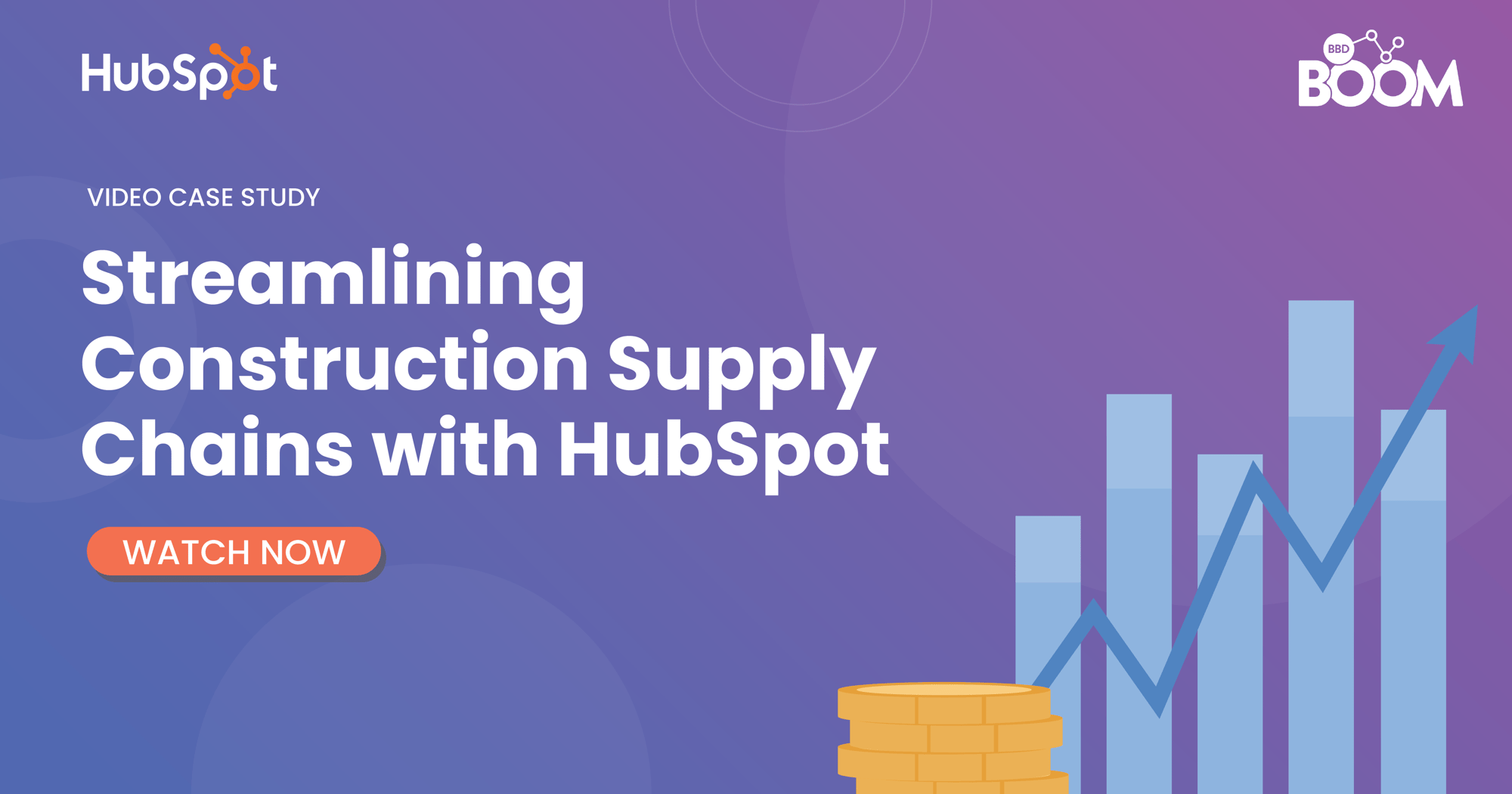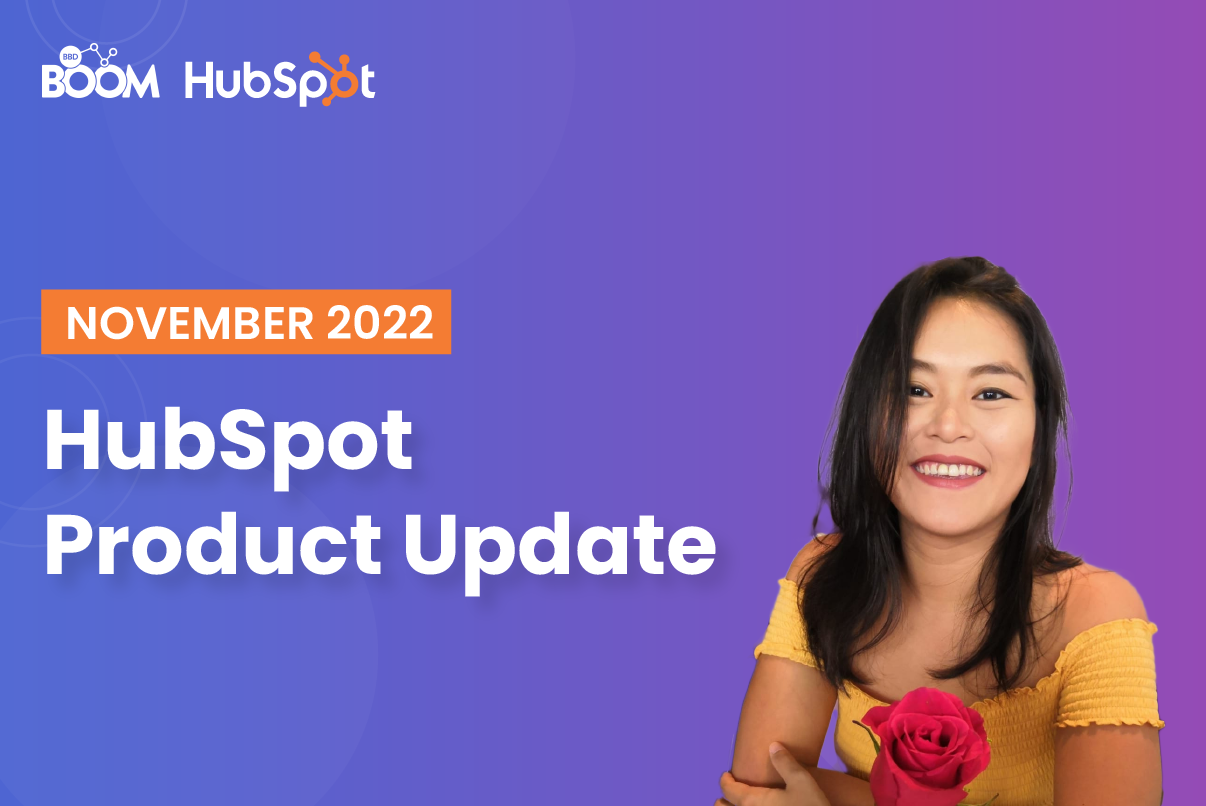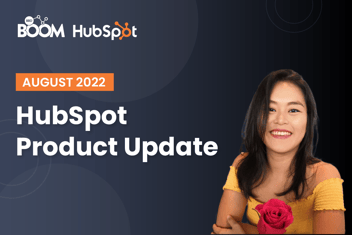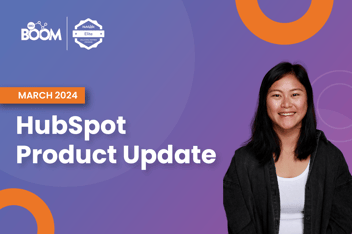Welcome to our HubSpot Product Spotlight for October! In this blog, we’ll explore some of the team's favourite HubSpot updates from the last month. Ready? Let’s dive in!
Now Live
These are all the features now live and ready to use in your HubSpot portal.
Add Line Items when Creating Deals in Workflows
What is it?
You can now add line items to new deals you create within workflows!
Why does it matter?
Workflows allows you to create deals in a timely, personalized, and automated way. But if you wanted to add line items to those deals, you previously had to separately manually add the line items to the deals, use the Line Items API, or import them.
With this new update, you can now add line items to the deals you're creating in automation, cutting out those manual tasks so you can spend more time on things that matter most.
Import Sales Activities
What is it?
You can now import sales activities into HubSpot, and associate them with other objects. These activities include sales emails, tasks, meetings, and calls. The import tool already supports the ability to import notes.
Why does it matter?
New users adopting HubSpot want to be able to reflect their business within our CRM. This not only means tracking the contacts, companies, deals, etc. that they engage with, but also how they’re engaging with them.
- Have they had a meeting with a prospect at a target account?
- Did they have a kick-off call with that customer that just signed on last week?
- Has the new sales rep finished the tasks assigned to them on their open accounts?
- Have sales reps emailed deals in flight about their end of month discount?
We’ve always allowed users to manually log these activities on different records in the CRM, but haven't supported adding them in bulk via import. Now, with the ability to import tasks, calls, sales emails, and meetings into HubSpot, users can quickly and confidently reflect their business processes within the CRM using the import flow they’re already familiar with.
New to HubSpot’s Eventbrite integration: Create and update contacts in marketing events object
What is it?
HubSpot’s Eventbrite integration now can automatically create and update HubSpot contacts in HubSpot’s marketing event object. Now the integration can:
- Create new contact records in HubSpot’s marketing events object when new customers register or attend Eventbrite events.
- Add activities to HubSpot contact records’ timelines when customers register for, attend, or cancel registration for Eventbrite events. Activities will include details such as the event's name, how long the contact attended, and more.
Why does it matter?
Previously, HubSpot’s Eventbrite integration couldn’t create and update contacts in HubSpot’s marketing event object, making it difficult to pull in information about your events throughout HubSpot.
Now, when contacts attend, register for, or cancel registration for Eventbrite events, that information will be automatically added to the HubSpot’s marketing event object, so your team can easily see information about these contacts and their timeline activities for marketing events throughout HubSpot, such as attribution reporting, list segmentation, workflows and more. See this knowledge base article to learn more about HubSpot's marketing events object.
Updates to List Folders
What is it?
You can now create lists directly in the folder you are browsing and view the full folder path once inside any list.
Why does it matter?
List folders help you organize your most important customer segments. Creating lists directly inside a folder and being able to view their paths makes it even easier to keep your audiences organized.
Files Tool - Video Advanced Features Filter
What is it?
You can now filter to see which videos have advanced features enabled in your Files tool dashboard.
Why does it matter?
For videos with "advanced features", you can take advantage of a multitude of features such as analytics, list segmentation, forms, CTAs, subtitles, and more. However, there is a limit to the amount of videos that can be enabled for advanced features.
To help you better manage which videos count towards your limit we are introducing a new filter on the Files tool dashboard. With just a few clicks, you can now check how many videos in your portal are enabled for HubSpot Video, and ensure that only the most relevant videos are counted towards your limit.
Audit log of users security actions in-app
What is it?
Super Admins can now view their account's security activity history through an in-app audit log.
Why does it matter?
Super Admins can now view an audit log of security-related actions that users have taken in the account, such as:
- adding, removing, requiring, or removing the requirement for single sign-on (SSO)
- exporting contacts
- adding or removing users
- deactivating or reactivating users
- viewing, creating, or deactivating an API key
- turning email tracking and attachment logging settings on or off
- adding or removing email recipients from the Never Log list
- performing a GDPR delete of a contact
- installing integrations
- sending manual registration emails or password reset emails
- creating a payment account and updating information, account changes, or sending payment onboarding links
- creating, syncing, or deleting sandboxes

Previously this information was an export-only feature which meant downloading a new .CSV file every time a super admin needed to review up-to-date data.
Audit log of users login history in-app
What is it?
Super Admins can now view their account's user-login history through an in-app audit log.
Why does it matter?
Admins are often the point of contact for both their account users, when things go wrong in their portals, and for their companies when required to provide details and data for security and compliance audits.
With this new UI, Super Admins can view a real-time audit log of their users' login activity. This audit log contains the following information about each login attempt:
- login timestamp
- user email address
- login success/fail status
- IP address
- location
- user agent (information about the device used for logging in)

Previously this was an export-only feature which meant downloading a new .CSV file every time a super admin needed to review up-to-date data.
New updates to your Campaigns 'influenced contacts' metric
What is it?
The ‘influenced contacts’ metric is defined as ‘the number of new or existing contacts that engaged with one or more assets in this campaign’ and is one of the most critical campaign data points.
We’ve now upgraded all campaigns to the newest edition of the 'influenced contacts' metric.
Why does it matter?
Until now, there were limitations around the 'influenced contacts' metric that made it difficult to derive insights. With this update, you can now:
- Understand how each contact was influenced (filtered by asset type and asset) alongside the list of contacts.
- Filter specifically for 'influenced contacts' data on the Campaigns details page as well as in the 'Campaign Analytics' report.
- Use 'influenced contacts' data to create active lists.
Payments support for write-in taxes & fees from Quotes
What is it?
Customers can now include write-in taxes and fees on quotes that will be paid with HubSpot Payments.
Previously, quotes that included taxes and fees were blocked from collecting payments using HubSpot Payments with an error message that required these additional items to be removed.
Why does it matter?
A significant number of customers include taxes and fees on quotes because the sale of certain goods or services requires it to comply with local rules and regulations. For these customers, the inability to include taxes or fees meant that HubSpot Payments wasn't an option for their business.
Date Attribute on Non-Hubspot Forms
What is it?
We've added a new data attribute to manage dates for text inputs to non-Hubspot Forms.
Why does it matter?
Customers can now set the attribute in their Form HTML to instruct non-Hubspot Forms how to handle text inputs meant exclusively for collecting dates. This means they'll have higher quality CRM data for date values.
Integrate WhatsApp with HubSpot
What is it?
The ability to connect a WhatsApp Business Account as a channel in the conversations inbox. Once connected you can manage and reply to any incoming messages in the inbox. Your approved WhatsApp templates will also sync to HubSpot allowing you to personalize the templates with data from the CRM. Templates can be sent from workflows to start conversations with contacts.
Why does it matter?
WhatsApp is the communication method of choice for over 2 billion people. Having WhatsApp as a channel in HubSpot allows you to communicate with contacts on their channel of choice across the front office suite.
Share Call Recording Clips with Your Team
What is it?
Users can now share call recording clips with defined start and end times with their teammates. This enables users to highlight and direct their teammates to the most important part of a recording.
Why does it matter?
Until today, users could share clips that started at a specified time in the recording, but they had no ability to set an end time. This would sometimes leave the recipients confused or unsure as to when they should stop listening. By adding the ability to define end times, we're ensuring recipients can stay focused on the most impactful part of a call recording.
Clips make it easier than ever to:
- Ask for and provide targeted feedback
- Share and celebrate team wins
- Provide reps with an example of what good looks like
- Collaborate cross-functionally
- Amplify the voice of the customer by easily sharing prospect feedback directly with other teams and leadership
Simpler Payments Settings Organization
What is it?
A revised, simpler organization within payment settings makes finding configuration options easier for HubSpot payments customers.
Why does it matter?
Customers often cite difficulty finding what they need within payments settings due to a lack of clear, obvious labels and language. In addition, Payments has an increasing number of important settings for our customers to manage as we continue to add new and improved functionality. This new organization adds clarity and provides a strong foundation for adding additional settings in the future.
Self-Hosted Web Fonts
What is it?
Google Fonts loaded using theme or module fields in Website Pages and Landing Pages will now serve the fonts from your domain name instead of Google's servers.
No action is required on your behalf as a result of this change.
Why does it matter?
Due to changes in how modern web browsers cache cross-domain assets, there's no longer a benefit to loading speed when multiple domains load the same fonts from fonts.googleapis.com, since assets are now cached in relation to the current domain.
Additionally with HTTP/2 it is better to host assets at the same domain. Reducing the number of domain names used results in fewer DNS lookups, SSL handshakes, and enables reusing the existing HTTP/2 connection used for the other assets on the page.
As a result of this change, pages hosted on HubSpot that have Google Fonts selected within a theme/module field may see a small performance improvement. In our testing, the new method of loading the fonts on average provided slightly better scores for Core Web Vital metrics. Results may vary based on number of fonts, file size of fonts and other conditions unique to each site.
Descriptions for HubDB table columns
What is it?
The ability to add a description to HubDB table columns to make it easier for content creators to understand how to use a column.
Why does it matter?
Sometimes, the way to use HubDB columns can be difficult to understand as a content creator. The ability to add a description allows developers to give content creators helpful hints for inputting data, such as a reminder about what image size should be used, how long a description should be, and more. It can also be used to explain where on the website a given column's data will show up.
Recommend playbooks based on Contact or Ticket property values
What is it?
We recently added the ability to recommend playbooks based on the value of the Deal Stage property in Deal records. Now we're expanding the recommendation feature to include Contact and Ticket properties so you can recommend playbooks in prospecting and service scenarios.
Customers can now recommend playbooks to users based on the value of the Lead Status or Lifecycle Stage properties in Contacts or the Ticket Status or Category properties in Tickets.

Why does it matter?
Playbook recommendations prevent reps from wasting time looking for the right playbook. Recommended playbooks are flagged and automatically pushed to the top of the list of playbooks based on the stage or status of that contact or ticket record. This way your reps can quickly access the playbook designed for that occasion.
For instance, this feature can be used to support prospecting by recommending playbooks on contact records using the Lead Status or Lifecycle Stage properties, or in specific support cases by using the Ticket Status or Category properties.

Beta
These updates are currently in the works and nearly ready to be released on your HubSpot Portal.
Surface pipeline stage properties when creating a record
What is it?
Today, you can set properties as visible or required for each deal stage or ticket status in Deal or Ticket Pipeline settings. These properties are currently surfaced when users switch stages, but not when they create a new deal or ticket. We’re closing this gap by dynamically surfacing properties in the Create Deal and Create Ticket forms depending on which pipeline stage a user selects.
This feature is available to all Starter+ customers.
Note: These changes are not reflected in the mobile experience yet. If your company creates records using the mobile app, we don’t recommend opting into this beta at this time.
Why does it matter?
Rep efficiency and data quality are HubSpot admin priorities. With this feature, you will be able to save sales rep time by surfacing the properties that are relevant to the specific deal stage or ticket status of a new record. You will also gain more control over data quality by ensuring that the right data is entered when a new deal or ticket is created.
Payments support for write-in taxes & fees from Quotes
What is it?
Customers can now include write-in taxes and fees on quotes that will be paid with HubSpot Payments.
Previously, quotes that included taxes and fees were blocked from collecting payment using HubSpot Payments with an error message that required these additional items to be removed.
Why does it matter?
A significant number of customers include taxes and fees on quotes because the sale of certain goods or services requires it to comply with local rules and regulations. For these customers, the inability to include taxes or fees meant that HubSpot Payments wasn't an option for their business.
Test A Record Update (Lists)
What is it?
Updates to the Test a Record feature for Lists that make it more clear why your test record passed or failed the filters.
Why does it matter?
After you create the filters for a list, the test feature helps you understand why a given record would pass or fail your filter criteria. This update makes the information we surface about which filters were passed or failed, far more granular and actionable.

Now, instead of only letting you know that your record doesn't meet all of the requirements in all of 'Group 1', we'll show you specifically which filters it didn't meet in each filter group and why - giving you the information you need to make updates to the record or to the filters.
Audit log of users login history in-app
What is it?
Super Admins can now view their account's user-login history through an in-app audit log.
Why does it matter?
Admins are often the point of contact for both their account users, when things go wrong in their portals, and for their companies when required to provide details and data for security and compliance audits.
With this new UI, Super Admins can view a real-time audit log of their users' login activity. This audit log contains the following information about each login attempt:
- login timestamp
- user email address
- login success/fail status
- IP address
- location
- user agent (information about the device used for logging in)

Previously this was an export-only feature which meant downloading a new .CSV file every time a super admin needed to review up-to-date data.
Schedule subscription on a future date
What is it?
You can now configure recurring products & services on payment links to start billing on a future calendar date. And coming soon: the same functionality on quotes.
Why does it matter?
At present, all subscriptions with HubSpot Payments start right after the buyer goes through the checkout. But many times the payment for recurring products needs to start on a date different from the checkout date of the buyer. Examples of such use cases are:
- Complete user onboarding or deliver a few milestones before charging the buyer on a regular basis
- Sell online courses & classes that are set to start on a fixed date in the future, and that's when the payment should be collected
- Align the billing cycle for all new buyers for easy accounting processes
Call Index Preview Panel
What is it?
A clean, consistent preview panel on the call index page that allows users to access their call recordings, call info, and associate objects in fewer clicks.
Why does it matter?
The preview panel on the call index page previously allowed users to listen to a call recording, share a call recording, and view/search the call transcript (if applicable). The new format increases efficiency and allows access to more summarized call data.
Approvals For Sending Marketing Emails
What is it?
The ability for marketers to request approval before sending a marketing email.
Why does it matter?
Today, marketers need to jump through too many loops before they're able to send a marketing email. They have to go back and forth using multiple external tools to make sure all stakeholders involved review the email. This decentralized process is inefficient, unproductive, and causes a lot of friction for customers.
Drag and Drop Modules in Blog Post Editing
What is it?
This feature allows you to drag and drop modules into the rich text area of your blog posts.
Why does it matter?
Users often try to hack their way to adding rich content to their blog posts, which ends up being time-consuming and often requires the help of a developer. This new feature gives you the ability to add modules to your blog posts, which makes the blog editing experience simpler and more intuitive.
.png?width=877&height=508&name=bbd-boom-siloy-navy+blue-logo%20(1).png)
.png)

.jpg)






.png?width=352&name=Boom_HS%20update_email_April_Resource%20(1).png)

